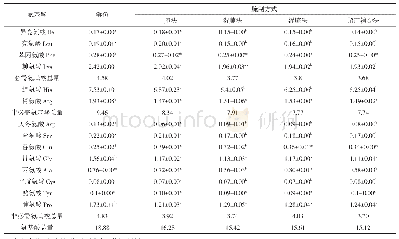《Table 2 Effects of different inoculation methods on inbred lines of maize》
 提示:宽带有限、当前游客访问压缩模式
提示:宽带有限、当前游客访问压缩模式
本系列图表出处文件名:随高清版一同展现
《玉米抗黄曲霉田间高通量鉴定方法构建及应用(英文)》
*Non-disease points have not been included in the statistics of average disease level.Values within each column for a year followed by different letters are significantly different at the 0.05 probability level.
The incidence and severity of the disease level of the inbred lines were significantly differen under the 3 inoculation methods(Table 2).The incidence and disease level of the non-invasive silk channel injection inoculation method,depended on the disease resistance of the inbred lines.H152 had the strongest resistance,no disease;PI143 had the highest incidence,but it was not completely infected,therefore it affects the judgment of strain resistance.The traumatic inoculation method could ensure the smooth proliferation of conidia,thus ensuring a high incidence.There was no significant differences in the incidence of different inbred lines between the two traumatic inoculation methods.Because most maize inbred lines have an irregular kernel arrangement,needles could not guarantee that every inoculation needle will pierce the kernel and cause disease.There is a high incidence of inbred lines with standardized kernel arrangement,such as H152.Spiral quantitative inoculation requires that the inoculation site must be on a single kernel,so it could ensure that the panicle of the inoculated plant was completely infected.The resistant phenotypes of other inbred lines could be accurately identified by comparing the high-resistant inbred line H152 with the high-sensitive PI143.Spiral quantitative inoculation with high accuracy could be applied to construct the model.
| 图表编号 | XD00199115600 严禁用于非法目的 |
|---|---|
| 绘制时间 | 2018.10.01 |
| 作者 | 齐耀程、丁舰舟、左晓龙、张玮、钱益亮、任四海、王俊、郭进、阮龙 |
| 绘制单位 | 安徽省农业科学院烟草研究所、安徽省农业科学院烟草研究所、安徽省农业科学院烟草研究所、安徽省农业科学院烟草研究所、安徽省农业科学院烟草研究所、安徽省农业科学院烟草研究所、安徽省农业科学院烟草研究所、安徽省农业科学院烟草研究所、安徽省农业科学院烟草研究所 |
| 更多格式 | 高清、无水印(增值服务) |





